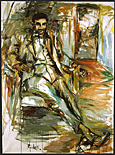
Author, critic
Rosenberg was a lifelong friend of Abstract Expressionists Willem and Elaine de Kooning. If Willem was "the king of art" for Rosenberg the singular genius against whom all others were measured then Elaine was his educator, the person who taught him how to develop his eye. Rosenberg and Elaine de Kooning shared a relationship that was stimulated by involved intellectual conversations and debates on artistic theory. Her energetically painted portrait of him merges portraiture's demand for likeness with Abstract Expressionism's demand for intuitively created surfaces.
Elaine de Kooning (1918-1989)
The most vocal proponent of the Abstract Expressionist movement and the originator of the term "action painting," Harold Rosenberg was renowned for his fiercely intellectual criticism on art, politics, and society. He considered Abstract Expressionism "the most vigorous and original movement in art in the history of this nation." Locating the work of art's supreme value in the act of creation, Rosenberg positioned himself squarely opposite the formalist critic Clement Greenberg. His 1952 article for ARTnews, entitled "The American Action Painters," was adopted as Abstract Expressionism's manifesto and had a profound effect on the artistic landscape of 1950s New York.
Oil on canvas, 1956
National Portrait Gallery, Smithsonian Institution
NPG.94.14
Enlarged image
© 2002 Smithsonian Institution

